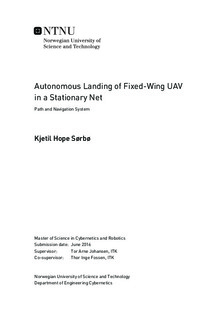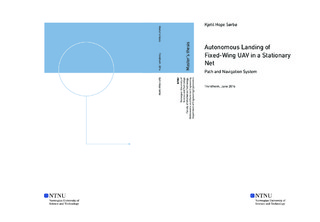| dc.description.abstract | This thesis present a path and navigation system, used in a autonomous
net landing system for a fixed wing Unmanned Aerial Vehicle (UAV). A
landing path of a UAV can be constructed as a straight line path, but in
order for a UAV to follow the landing path it must be in a position from
which it has a feasible path to the start position of the landing path. This
motivates the development of a approach path logic towards the landing
path entry position from any initial start position in the air space.
In addition to a path generation system the UAV require a robust
high accurate navigation system. This is accomplished by applying Real
Time Kinematic GNSS (RTK-GNSS), which can provide centimeter level
position accuracy. A shortcoming of the RTK-GNSS system is that it may
loose its lock on satellites leading to loss of functionality. In this work
this is compensated for by introducing a secondary Global Navigation
Satellite System (GNSS) system. To handle a RTK-GNSS drop out a
robust RTK-GNSS system is proposed, where previous valid RTK-GNSS
position solutions are fused together with the secondary GNSS system,
to be used as a compensator for the external navigation system. The
compensator is designed to enable the external navigation system to
achieve the same position accuracy level as the RTK-GNSS system for a
short duration, until the RTK-GNSS is either reconnected or completely
disconnected. With the compensator the UAV navigation system becomes
robust against short drop out of the RTK-GNSS, and the availability of
the RTK-GNSS is prolonged.
Experimental testing, in addition to Software In the Loop (SIL)
verification, of the ability of UAV to land in a stationary arbitrary placed
net has been performed. For improved navigation and performance, an
mobile sensor unit have been utilized to provide the required position
data of the net. This sensor unit was used during testing, where it showed
to provide the intended contribution. | |

